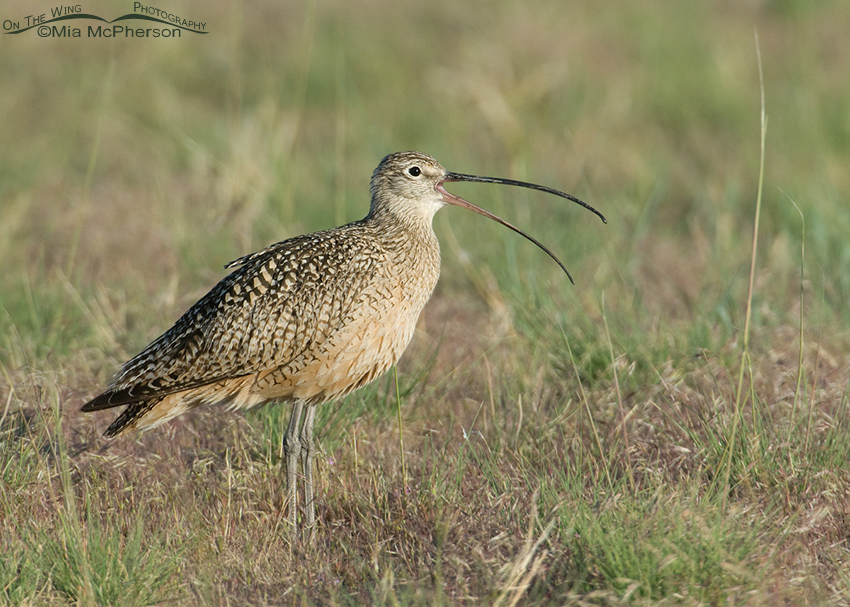I haven’t heard a Long-billed Curlew calling for several weeks here in northern Utah and I already miss hearing their calls. I photographed this calling male the second week of May out on a grassy flat on Antelope Island State Park.
 Long-billed Curlew male calling – Nikon D200, f7.1, 1/640, ISO 500, +0.3 EV, Nikkor 200-400mm VR with 1.4x TC at 400mm, natural light
Long-billed Curlew male calling – Nikon D200, f7.1, 1/640, ISO 500, +0.3 EV, Nikkor 200-400mm VR with 1.4x TC at 400mm, natural light
Long-billed Curlews are generally silent away from the breeding grounds, I never heard one make a sound when I would see them in Florida during the nonbreeding season.
Long-billed Curlews are also known as “sicklebirds” and “candlestick birds”. Candlestick Point in San Francisco was named after them.
Last year at about this time I was still seeing Long-billed Curlews and their young on Antelope Island State Park but it had been a long, cold and wet spring so breeding may have been delayed. This year they either nested on time or perhaps a bit earlier which may be why I am not seeing their young right now.
Still, seeing them anytime of the year is a joy for me.
Life is good.
Mia
Click here to see more of my Long-billed Curlew photos plus facts and information about this species.


The link: http://www.xeno-canto.org/13612
Great shot of the male Curlew sounding off Mia. I have never heard one call so you have inspired me. Your readers might be interested in hearing the recording. Here is a link to the Long-billed Curlew call at Xeno-Canto, the best resource for bird calls I know.
Thanks Larry. My iBird Pro app has the call that I have mentioned but I’m not able to find just the right one on line yet, when I do I will post a link to it.
Great shot, and listening now to calls. I have only seen one once but never near breeding grounds.
Maybe one day you’ll see one on their breeding grounds Dan, the call is awesome. Thanks for your comment.
It amazes me at how thin the beak really is. It reminds me of the ‘form follow function’ paradigms in Nature.
Maria, the bill is very thin and I’ve often wondered how it can poke it into the mud without causing damage. Thanks for you comment.
I still remember the first time I saw one. I was astonished! that beak is so amazing. I do not think I have ever heard a curlew call though! I do believe its call has inspired poetry. I need to hear one for myself! Wonderful shot!
Kathie, you may be right, the curlew call I hear the most is mysterious enough to inspire poetry! Thanks for your comment.
Wow, awesome bird and a great shot! Wonderful post!
Thank you for commenting Eileen!
So glad you DID see this one…and had your camera ready.
Thank you merrill, they are great fun to photograph.
Wonderful Picture Mia. As a species, birds run the gamut with body shape and design don’t they, and adapt long bills or legs as their environments dictate. Would be interesting if we humans did the same thing ;).. people with enormous legs or noses .. etc well made me chuckle considering the idea
well made me chuckle considering the idea 
Stu, you made me chuckle too, I wonder if bird photographers would have three legs so they could be human tripods? Or have ears the size of weathervanes to hear the subjects better to locate them. Maybe a combination of the two?
Love this photo Mia. You always have something interesting to see. Your photo made me look online to hear what they sound like.
Linda, thanks for commenting. So far I haven’t found a link to the Curlew call I mention. It is on my iBird Pro app.
Those skinny legs and that long thin bill. They are beautiful. Carol
Thanks Carol, I agree, they are beautiful!
you have your own yankee model.
we get the eurasian ones. i think they are Numenius madagascarensis [sic]
or something like that.
cheers.
steve
Thanks Steve, I’ve seen photographs of Curlews from your neck of the woods, I’d love to see them in person one day.